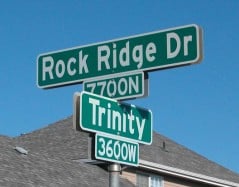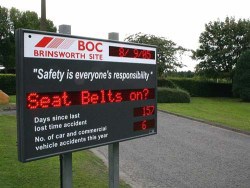In this second article on the brief history of signage, we’ve now covered everything up until the 18th century until the present, and my hope is that you’ll have a great handle, whether you wanted a handle on it or not, all about sign making.
 Hi again…as I said last time, if you look around, or drive around, when you live in any industrialized country on earth, your locale is full of signposts. Most of us simply accept that sign makers are all about signs and printing and that’s the extent of your thought on the subject.
Hi again…as I said last time, if you look around, or drive around, when you live in any industrialized country on earth, your locale is full of signposts. Most of us simply accept that sign makers are all about signs and printing and that’s the extent of your thought on the subject.
From Neon and Internally Illuminated Signs to Full Color LED Displays
18th to 19th Century
As I stated in the final part of the of the last article, by the 18th century and into the 19th century, signage displays became an art form, and some artists actually made their living doing mostly of them. In the 19th century also, some establishments began to use oil lanterns to light the surface of their signs if they were available in the evenings for business, such as a pub or an inn or an apothecary. In a sense, this was the beginning of illuminated displays.
While some were fancy, and others plain, this technology didn’t change dramatically in the 19th century, although one type that has existed since possibly before this time were cast metal letters, particularly bronze. However, I was unable to find much information yet on the history of this type, but due to the cost of metal, I am assuming average business were more able to afford painted wood signs than cast metals or plaques.
However, with the introduction of electricity in the late 18th century, it was only a matter of time before an enterprising electrician would figure out how to completely change this kind of graphic industry.
Neon Signs
 In 1910, Georges Claude first demonstrated neon display to a large public forum at the Paris Auto Show. The result was electrifying (hahaha!). Neon became very popular by the late 1920’s as a form of signage, especially in the US and Western Europe, and remained the most popular form of electrical sign into the 1960’s, when the internally illuminated fluorescent kinds (actually developed in the 1920’s) replaced it due to cost factors.
In 1910, Georges Claude first demonstrated neon display to a large public forum at the Paris Auto Show. The result was electrifying (hahaha!). Neon became very popular by the late 1920’s as a form of signage, especially in the US and Western Europe, and remained the most popular form of electrical sign into the 1960’s, when the internally illuminated fluorescent kinds (actually developed in the 1920’s) replaced it due to cost factors.
Custom neon signs are still popular today, although due to its cost, it is not used nearly as much as it was in the past. With the advent of LED lighting, LED neon signs’ popularity has continued to erode, mainly due to cost. Neon will never be completely replaced, though, as it is still the brightest light in this business. It can light up an outdoor or indoor environment (for home, room, or bedroom).
LED Signs
 As of 2003, according to Signs of the Times industry magazine, 46% of all types manufactured have fluorescent internal lighting, compared to 41% which are internally illuminated led signs with neon. The big gainer recently has been Animated LED (light-emitting diode) signage, also known as the electronic reader board.
As of 2003, according to Signs of the Times industry magazine, 46% of all types manufactured have fluorescent internal lighting, compared to 41% which are internally illuminated led signs with neon. The big gainer recently has been Animated LED (light-emitting diode) signage, also known as the electronic reader board.
LED message signs such as the electronic reader board, an outdoor programmable led sign, can be made as large as a huge billboard, and can have enough pixels (small LED lights) to make a moving picture like a movie screen. Oddly, while many municipalities have outlawed chase lights on the perimeter of a neon or fluorescent-lighted graphic due to the motion being dangerous to drivers, programmable LED signs are popping up all over the country with their moving and changing copy, pictures, and logos. Some examples include LED light, stop, bar, beer, open, or exit signs.
However, I’m not big on government regulation, so as long as they’re able to collect taxes on these, they’ll probably continue to allow them, and the revenue is significant for the government.
In Part 3, I’m going to back up a ways chronologically and talk about signs and printing, from papyrus to Gutenberg to the desktop printer.
Find the third part of this series in here: www.visigraph.com/signs/sign-makers-a-history-of-signs-and-printing-part-2/
Popular Posts:




